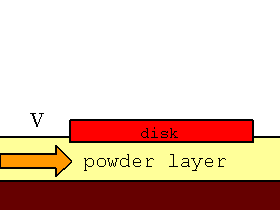| Measurement of Friction Coefficient on a Powder Layer and Fluid Dynamic Study |
The experimental result shows that the disk with base plastered with powder gives lower friction coefficients than for those having smooth metal surface (see Results of comparison experiments 3). It is also shown that the powder layer under the disk moves in the sliding direction (see Major results 5). These results suggest that reduction of powder speed relative to the disk is relevant to floating.
|
Assuming that the powder layer is a fluid layer, we can expect the generation of dynamic pressure following the reduction in relative velocity. We call this model the dynamic pressure model (Fig 24). In this model, we consider only one- dimensional movement; the powder does not escape to the side of the disk. This is supported from the experimental results where the powder remained unaffected except inside the track of the disk. When the relative velocity becomes zero just beneath the disk, the dynamic pressure p is given as p = r V2/2, where r is the density of the powder layer and v the disk speed. Therefore, the critical speed of floatation vc, at which the dynamic pressure can support the disk, is given as vc = ( 2P / r )1/2, where P is the basal pressure of the disk. |
 Fig. 24. Schema of dynamic pressure model. Just beneath the disk, dynamic pressure is established corresponding to the decrease in relative velocity of the powder layer to the disk. |